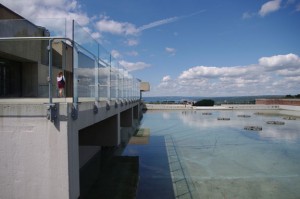
Electrical consumption at Ithaca College has been on a steady decline over the past few years, and the college saved more than $1 million in utilities for the 2009-10 academic year, Carl Sgrecci, vice president of finance and administration, said.
The college underspent last year’s utilities budget of $7.9 million by $1.6 million, Sgrecci said.
“Despite the fact that we have added some space to the campus in the last several years, our energy consumption really has declined, and as a [result] of that, we have been able to hold our electrical costs down,” Sgrecci said.
Energy conservation measures play a role in the declining electrical costs and are being executed across campus in different forms. Some of those efforts include replacing many of the older indoor and outdoor lighting fixtures with more energy-efficient ones, rewiring older energy motors and upgrading heating and cooling units — changes that are often
invisible to most people on campus, Sgrecci said.
“The biggest factors are literally taking advantage of all the efforts we can reasonably afford,” he said.
Marian Brown, special assistant to the provost, said the energy conservation accomplishments can be attributed to the hard work of facilities crews and students.
“The decline in utilities usage, our electricity and natural gas use, are a direct reflection of the great work that’s going on by our facilities professionals,” she said.
The Office of Facilities is currently working on renovating the Dillingham Center fountain power system to lower overall energy consumption.
Rick Couture, associate vice president of the Office of Facilities, said the fountains have previously ran off of one single 100-horsepower motor. The renovations will change the constantly running motor to 16 separate five-horsepower motors, each only in use when that specific fountain is running. The fountains are expected to be up and running by Fall Splash, the college’s combined Alumni and Homecoming Weekend, Oct. 1-3.
The Focus on Colleges and Universities Program, a part of the New York State Energy Research and Development Authority, also helps the college with savings by offering monetary assistance for using sustainable practices. The program is one of NYSERDA’s many incentive programs but is geared specifically toward institutions of higher education.
Focus on Colleges and Universities offers incentives to institutions for reducing their energy use and implementing energy-efficient practices. The funding supports new construction, renovations and equipment upgrades — changes Sgrecci said the college is continuously implementing wherever it can.
“Whenever we do qualify, we tend to take advantage of [it],” he said.
NYSERDA’s program aims to help colleges prioritize their needs by helping them understand and implement conservation programs on their campuses, Jeffrey Gordon, spokesman for NYSERDA, said.
“Energy efficiency is most critical for all institutions that are trying to decrease their carbon footprint and reduce [their] impact on the environment,” Gordon said. “By making small changes in operations, institutions can make very large beneficial investments in energy efficiency [and] reap large rewards in energy savings.”
Since 2003, NYSERDA has funded the college with more than $600,000 in project and technical funds. Brown said it is equally important to make the most of the money the college saves.
“We are trying to stretch college dollars,” she said. “We want to reduce utilities consumption, but we want to maximize the way we spend our funds.”
The college’s relationship with NYSERDA has been a positive for both parties, Brown said. While the incentive program is helping the college save, the college is also helping NYSERDA tap into new incentive programs by acting as a model for other institutions.
“It’s a very mutually beneficial kind of program,” Brown said. “We are taking advantage of so many ways to reduce energy, and we are a good test bud, looking at large-scale [possibilities] on a campus with mostly 50-year-old buildings [and asking], ‘How do you make them more efficient?’”
Another way the college saved money during the past few years was in the construction of the Peggy Ryan Williams Center and the Park Center for Business and Sustainable Enterprise. Sgrecci said NYSERDA monetary incentives were taken into account before and throughout their construction.
“Those buildings didn’t exist with old technologies,” Sgrecci said. “To even qualify for those incentives, we [underwent] extreme energy conservation efforts in the design of the heating and cooling systems.”
But even with all the renovations and energy conservation measures the college is working on, Sgrecci said some students view efforts of the campus community as “small.”
He said even the smallest of sustainable practices shouldn’t be dismissed or underplayed.
“All of those things on an individual basis may seem small, but on a collective basis … those small numbers add up,” he said.
Brown said tangible results are directly related to the efforts of the campus community.
“We can make our buildings as … energy efficient as possible, but it really comes down to, in large measures, the occupants of … those buildings to help us go further with this,” she said. “People can be really helpful if they can be cognoscente of their energy use.”







